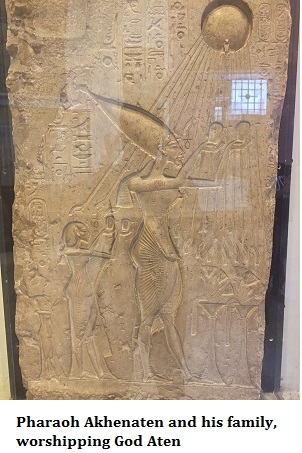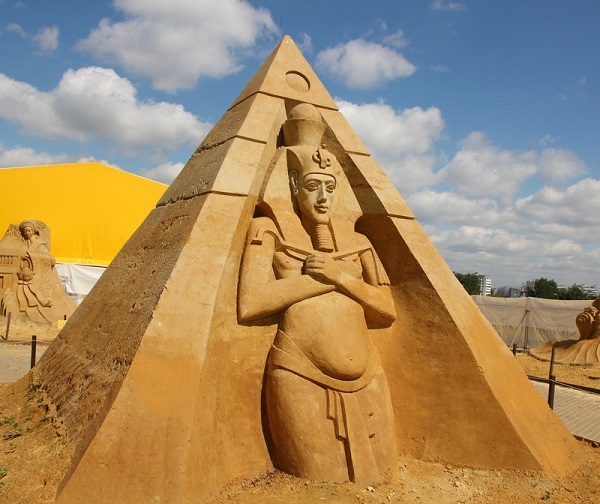

 The Amarna Period, also known as the "Amarna Revolution," was a period of time in ancient Egyptian history that lasted from approximately 1353 to 1336 BCE. The Amarna Period was characterized by a religious revolution led by the pharaoh Akhenaten, who attempted to establish the worship of the god Aten as the sole religion of Egypt.
The Amarna Period, also known as the "Amarna Revolution," was a period of time in ancient Egyptian history that lasted from approximately 1353 to 1336 BCE. The Amarna Period was characterized by a religious revolution led by the pharaoh Akhenaten, who attempted to establish the worship of the god Aten as the sole religion of Egypt.
The pharaohs' names and images were erased from many monuments and temples from this period, which has made it difficult to understand the events of the time. The capital of Egypt was moved from Thebes to a new city called Akhetaten (modern-day Amarna) during this time.
The Amarna Period, also known as the "Amarna Revolution," was a period of time in ancient Egyptian history that lasted from approximately 1353 to 1336 BCE.
It was characterized by a religious revolution led by the pharaoh Akhenaten, who attempted to establish the worship of the god Aten as the sole religion of Egypt.
The capital of Egypt was moved from Thebes to a new city called Akhetaten (modern-day Amarna) during this time.
Akhenaten and his family, including his wife Nefertiti, were depicted in a new style of art that emphasized naturalism and individualism.
The pharaohs' names and images were erased from many monuments and temples from this period, which has made it difficult to understand the events of the time.
The 18th dynasty of ancient Egypt was marked by the rule of powerful pharaohs, including Amenhotep III and his son Akhenaten.
Akhenaten's father, Amenhotep III, had built several temples to the god Aten, but it was not until Akhenaten came to power that Aten became the state god of Egypt.
Akhenaten's religious revolution was not well received by the powerful priests of the traditional gods, and it is likely that there was considerable resistance to his rule.
The pharaoh's decision to move the capital from Thebes to Akhetaten also had a profound effect on the administration of the country, as officials were forced to relocate and the country was divided into two parts.
The Amarna Period was a time of great change in Egypt, with far-reaching political, religious, and cultural consequences.
The pharaoh Akhenaten is also considered as a controversial figure in the history of ancient Egypt, as his religious revolution was met with resistance and was later reversed by his successors.

Pharaoh Akhenaten’s statue
Art during the Amarna Period was characterized by a new style that was more naturalistic and less formal than traditional Egyptian art.
Akhenaten and his family, including his wife Nefertiti and daughters, were depicted in a distinctive style that emphasized their individuality and naturalism.
The art of the Amarna Period was also characterized by a new way of depicting the human form, with elongated heads and necks, sloping shoulders, and a pronounced belly.
The pharaohs' images and names were erased from many monuments and temples, which has made it difficult to understand the events of the time.
The art of the Amarna Period also reflected the new religious ideas of the pharaoh, with many representations of the god Aten and the solar disc.
The art of the Amarna Period continues to be studied by Egyptologists and art historians for its unique style and insights into the religious and cultural changes of the time.
The Amarna Period marked a major shift in the religious and cultural beliefs of ancient Egypt, as the pharaoh Akhenaten attempted to establish the worship of the god Aten as the sole religion of Egypt.
This religious revolution had a significant impact on the administration and economy of the country, as the temples of the traditional gods were stripped of their wealth and power.
The art of the Amarna Period was a major departure from traditional Egyptian art and continues to be studied for its unique style and insights into the religious and cultural changes of the time.
The period was brief but it left a lasting impact on the history of ancient Egypt, and its legacy continues to be studied and debated by historians and Egyptologists.
The period also showed the power of the pharaoh to implement a significant change in the religious beliefs of the empire and how it affected the society in the long run.
In conclusion, the Amarna Period was a significant period of change in ancient Egyptian history. It was marked by the religious revolution led by the pharaoh Akhenaten, who attempted to establish the worship of the god Aten as the sole religion of Egypt. The capital was moved to a new city, and the traditional gods were phased out. The period was brief, but it had a lasting impact on the administration and economy of the country. The Amarna Period was a turning point in the history of ancient Egypt, and its legacy continues to be studied and debated by historians and Egyptologists.
Q1. Who was the pharaoh during the Amarna Period?
Ans. The pharaoh during the Amarna Period was Akhenaten, also known as Amenhotep IV. He was the son of Amenhotep III and came to power around 1353 BCE. He is best known for his religious revolution, in which he attempted to establish the worship of the god Aten as the sole religion of Egypt.
Q2. What was the significance of the god Aten during the Amarna Period?
Ans. The god Aten was the central figure in the religious revolution led by Akhenaten during the Amarna Period. Aten was considered to be the sun-disk, representing the visible manifestation of the sun god, Ra. Akhenaten's religious reforms elevated the worship of Aten above all other gods, and the pharaoh even changed his name to Akhenaten, meaning "effective for Aten."
Q3. How long did the Amarna Period last?
Ans. The Amarna Period lasted for around 17 years, from approximately 1353 to 1336 BCE. It was a relatively brief period of time in ancient Egyptian history, but it was marked by significant changes in politics, religion, and culture